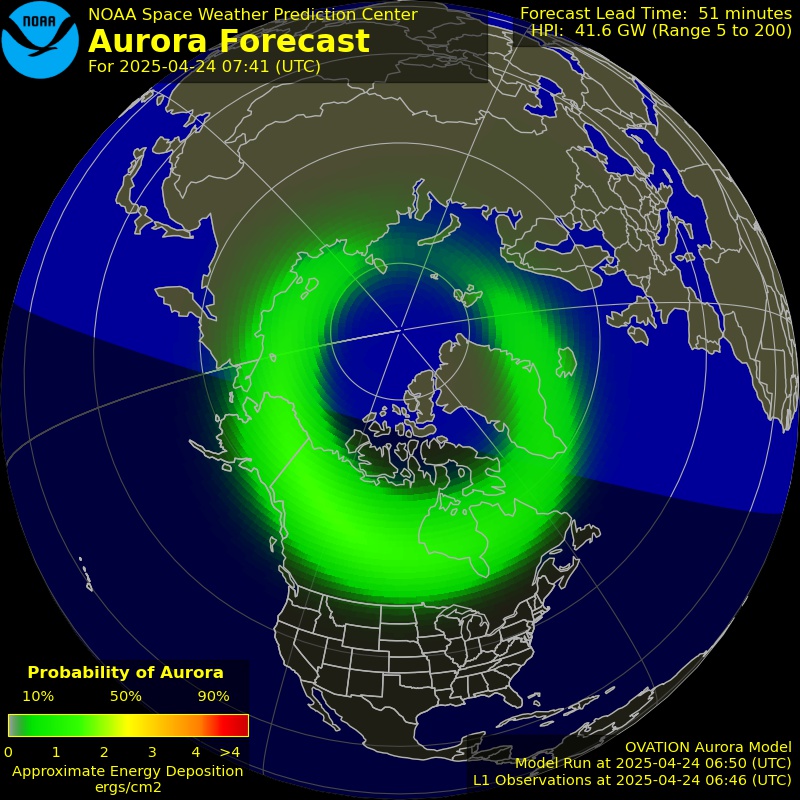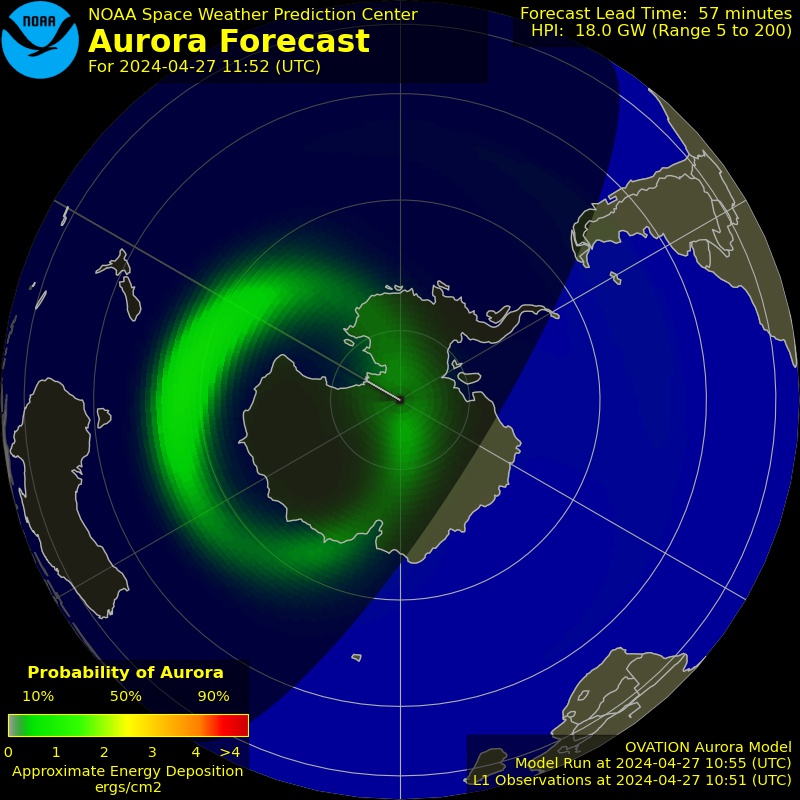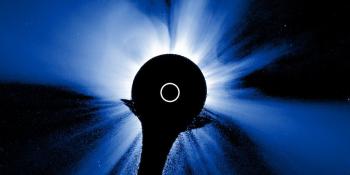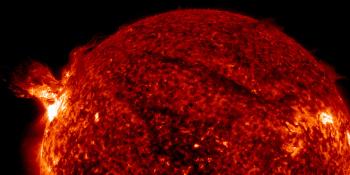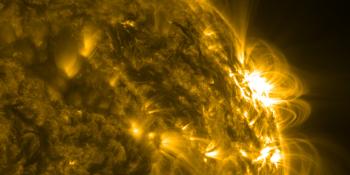OVATION Auroral Forecast
This model gives a short-term forecast of the intensity of the auroral oval for both the northern and the southern hemisphere. It is based on the solar wind and interplanetary magnetic field (IMF) conditions as measured by the ACE spacecraft. The map shows the intensity and the location of the auroral oval for the time given in the right-hand corner of the map. Locations up to 1.000 kilometers (600 miles) north or south of the auroral oval might still see aurora near their horizon during optimal viewing conditions. This model does not take into account the local weather or the altitude of the Sun at your location.
Hemispheric Power
The OVATION model calculates a globally integrated total energy deposition in GigaWatts for up to 30 minutes in the future. For values below about 20GW, there may be little or no aurora observable. For values between 20 and 50, you may need to be near the aurora to see it. For values above 50, the aurora should be quite observable with lots of activity and motion across the sky. Once the Hemispheric Power reaches levels of 100 or more, this is considered to be a very significant geomagnetic storm.
What are the odds that I can see overhead aurora from my location?
| Canada | |
|---|---|
| Alert, NU | 0% |
| Gillam, MB | 5% |
| Halifax, NS | 0% |
| Iqaluit, NU | 19% |
| Montreal, QC | 0% |
| Ottawa, ON | 0% |
| Quebec City, QC | 0% |
| Resolute, NV | 0% |
| St. John's, NL | 0% |
| Thunder Bay, ON | 0% |
| Toronto, ON | 0% |
| Greenland | |
|---|---|
| Nuuk | 25% |
| United States | |
|---|---|
| Augusta, ME | 0% |
| Boston, MA | 0% |
| Chicago, IL | 0% |
| Columbus, OH | 0% |
| Detroit, MI | 0% |
| Indianapolis, IN | 0% |
| Miami, FL | 0% |
| Montpelier, VT | 0% |
| New York City, NY | 0% |
| Richmond, VA | 0% |
| Washington, D.C. | 0% |
| Austria | |
|---|---|
| Vienna | 0% |
| Belarus | |
|---|---|
| Minsk | 0% |
| Belgium | |
|---|---|
| Brussels | 0% |
| Czech Republic | |
|---|---|
| Brno | 0% |
| Prague | 0% |
| Denmark | |
|---|---|
| Aalborg | 1% |
| Aarhus | 0% |
| Copenhagen | 0% |
| Estonia | |
|---|---|
| Tallinn | 4% |
| Faroe Islands | |
|---|---|
| Tórshavn | 15% |
| Finland | |
|---|---|
| Helsinki | 6% |
| Oulu | 20% |
| Rovaniemi | 22% |
| Tampere | 8% |
| Turku | 6% |
| Kuopio | 10% |
| Sodankylä | 24% |
| Utsjoki | 24% |
| France | |
|---|---|
| Lyon | 0% |
| Marseille | 0% |
| Nantes | 0% |
| Nice | 0% |
| Paris | 0% |
| Toulouse | 0% |
| Germany | |
|---|---|
| Berlin | 0% |
| Cologne | 0% |
| Frankfurt | 0% |
| Hamburg | 0% |
| Munich | 0% |
| Greece | |
|---|---|
| Athens | 0% |
| Hungary | |
|---|---|
| Budapest | 0% |
| Iceland | |
|---|---|
| Reykjavik | 28% |
| Ireland | |
|---|---|
| Dublin | 0% |
| Italy | |
|---|---|
| Milan | 0% |
| Naples | 0% |
| Rome | 0% |
| Turin | 0% |
| Kazakhstan | |
|---|---|
| Astana | 0% |
| Latvia | |
|---|---|
| Riga | 0% |
| Lithuania | |
|---|---|
| Vilnius | 0% |
| Netherlands | |
|---|---|
| Amsterdam | 0% |
| Norway | |
|---|---|
| Bergen | 6% |
| Kirkenes | 23% |
| Oslo | 4% |
| Tromsø | 26% |
| Trondheim | 16% |
| Poland | |
|---|---|
| Gdańsk | 0% |
| Krakow | 0% |
| Warsaw | 0% |
| Portugal | |
|---|---|
| Lisbon | 0% |
| Porto | 0% |
| Romania | |
|---|---|
| Bucharest | 0% |
| Russia | |
|---|---|
| Arkhangelsk | 13% |
| Irkutsk | 0% |
| Kazan | 0% |
| Krasnoyarsk | 0% |
| Moscow | 0% |
| Murmansk | 23% |
| Norilsk | 11% |
| Novosibirsk | 0% |
| Perm | 1% |
| Petrozavodsk | 7% |
| Saint Petersburg | 4% |
| Surgut | 3% |
| Syktyvkar | 6% |
| Vorkuta | 14% |
| Yaroslavl | 1% |
| Yekaterinburg | 0% |
| Slovenia | |
|---|---|
| Ljubljana | 0% |
| Slovakia | |
|---|---|
| Bratislava | 0% |
| Spain | |
|---|---|
| Barcelona | 0% |
| Madrid | 0% |
| Sweden | |
|---|---|
| Gothenburg | 1% |
| Kiruna | 25% |
| Luleå | 20% |
| Malmö | 0% |
| Stockholm | 4% |
| Sundsvall | 12% |
| Umeå | 14% |
| Switzerland | |
|---|---|
| Bern | 0% |
| United Kingdom | |
|---|---|
| Belfast | 0% |
| Birmingham | 0% |
| Edinburgh | 0% |
| London | 0% |
| Manchester | 0% |
| Ukraine | |
|---|---|
| Dnipro | 0% |
| Donetsk | 0% |
| Kharkiv | 0% |
| Kyiv | 0% |
| South Africa | |
|---|---|
| Capetown | 0% |
| Durban | 0% |
Latest news
Latest forum messages
Support SpaceWeatherLive.com!
A lot of people come to SpaceWeatherLive to follow the Solar activity or if there is a chance to see the aurora, but with more traffic comes higher costs to keep the servers online. If you like SpaceWeatherLive and want to support the project you can choose a subscription for an ad-free site or consider a donation. With your help we can keep SpaceWeatherLive online!
Space weather facts
| Last X-flare | 2025/12/08 | X1.1 |
| Last M-flare | 2025/12/19 | M1.0 |
| Last geomagnetic storm | 2025/12/12 | Kp5 (G1) |
| Spotless days | |
|---|---|
| Last spotless day | 2022/06/08 |
| Monthly mean Sunspot Number | |
|---|---|
| November 2025 | 91.8 -22.8 |
| December 2025 | 125.7 +33.9 |
| Last 30 days | 109.3 +18.1 |
